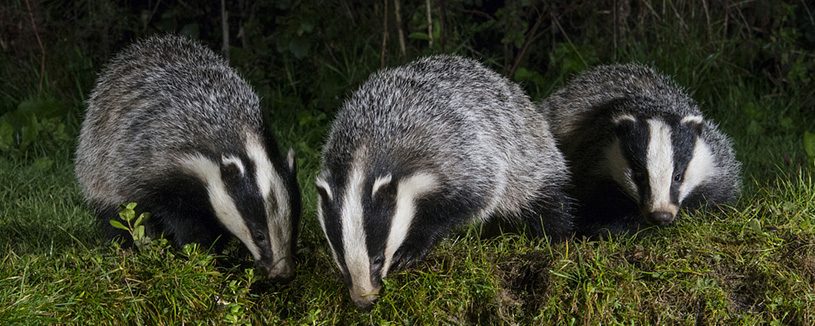
The London based Royal Society have published analyses that show how key aspects of methodology of the Randomised Badger Culling Trial (RBCT) published in Nature in 2006 were misdescribed and used implausible analytics. Original statistical appraisal that RBCT authors had claimed was too robust to require checking, was actually fallible, once clearly explained and tested.
The published Comment paper, addresses two scientific papers, also published in Royal Society Open Science in August 2024 by postdoctoral student Cathal Mills, supervised by Head of Department of Applied Statistics at Oxford University Professor Christl Donnelly, and Professor Rosie Woodroffe of the Institute of Zoology, (Mills et al I & II 2024). This work sought to defend the original analysis of the Randomised Badger Culling Trials (RBCT), (Donnelly et al 2006), which had been challenged by a full research paper published in Nature Scientific Reports in July 2024 (Torgerson et al 2024). A peer reviewer characterized one pivotal choice made in the two Mills et al. papers that tried to uphold the 2006 findings, as ‘naïve at best’.
Professor Paul Torgerson, Head of Epidemiology at the Zurich University Vet School, has led a team to undertake a detailed reanalysis of the original RBCT analysis. Papers derived from RBCT work have been used since 2013 by the Coalition, Conservative and now Labour Governments to justify badger culling. Labour however have called it ineffective, but without detailed explanation and have issued a new cull licence. Subsequent academic papers have relied heavily on the ‘ground zero’ Donnelly et al. 2006 publication to continue to claim that culling produces a disease benefit in cattle.
In Torgerson et al. (2024), and now also in the newly published and reaffirming Torgerson et al. (2025) “Comment” on the Mills et al (2024) papers, the most statistically and biologically plausible analytical options showed no evidence to support an effect of badger culling on bTB herd incidence. This is consistent with the 2022 analysis (Langton et al 2022) of part of the subsequent industry led badger culls in England (2013-2019), that was unable to detect any disease control benefit.
The “Comment“ also infers that the so-called “perturbation effect hypothesis” no longer holds convincing statistical support. This hypothesis first suggested in the 1970s was of badgers becoming frightened and disturbed (due to the catching and killing of them) consequently dispersing. Then directly or indirectly, badgers were alleged, to be responsible for multiplying the transmission of bTB to somehow cause half of TB cattle herd breakdowns. This mechanism was used to try to explain the claimed effect from the RBCT analysis.
The entrenched understanding of the role of badgers in bTB transmission to cattle over the last 20 years or so is further undermined and finally departs from any empirical support, sending a shockwave through beliefs that have become ingrained in farming, veterinary and Government thinking, where a high level of denial has already been in evidence since uncertainties were raised in 2019.
The implications of the new analyses are enormous, undoing extensive perceptions within multiple stakeholders that badger interventions are fundamental to any policy to control bTB in cattle. Whilst it clear that bTB introduced to wildlife from cattle is shared between wild mammals such as badgers, deer, rats and even domestic cats, exchange between wildlife and cattle has not been shown with sufficient precision in genetic studies to provide confidence. Infected wildlife may result simply from them being ‘spillover’ hosts, where infection dies out once disease is tackled in cattle. New cattle infections continue to occur due to poor testing sensitivity failing to identify disease, the incorrect designation of herds as ‘TB-Free’ when still infected, and continuous trading of infected calves and yearlings. The ongoing bTB crisis has cost the UK and Ireland an estimated £2 Billion in public payouts and lost productivity over the last 20 years alone, including over £1 Billion in England and Wales since 2013.
In 2024 the DEFRA Minister Daniel Zeichner invited Professor Sir Charles Godfray at Oxford University, to reconvene his 2018 review panel to consider the latest relevant scientific publications. Godfray, was involved in the statistical audit of the original RBCT analysis and in a 2013 report that appraised RBCT badger culling science, and a review in 2018 that recommended badger culling should continue. He has consistently endorsed RBCT statistics and badger culling.
The new paper and reviewer comments are available to read here.
Quotes from authors
Paul Torgerson, Professor of Veterinary Epidemiology at the Vetsuisse Faculty of the University of Zürich who has led the independent group said:
“The significance of our findings extends to several dozen papers written since 2006 that use the 2006 findings to build a theoretical case that badger interventions are a necessary part of bovine TB control in cattle, when they are not. Much work is now needed to highlight this issue by corrections, retractions and other measures to ensure students and practitioners are no longer misled. Bovine TB control must focus on inadequate TB testing and movement control of cattle where the problems are now well known.”
Tom Langton a nature conservation consultant within the independent group who has studied bovine TB control, has coordinated technical and legal scrutiny over badger culling since 2016. He said:
“The Government challenge to prevent further £1 billion spend over the next decade on more inadequate disease control will require fresh thinking and approaches. The Labour Government has rightly labelled badger culling as ‘ineffective’ and must surely now immediately cancel all badger culling licences while an inquiry is launched, as should Government in the Republic of Ireland, where thousands of mostly healthy badgers are also culled each year with no demonstrable reward. The failures of the TB testing system are now so well established it is unfathomable why prompt government action was not taken last year.”
Discover more from The Badger Crowd - standing up for badgers
Subscribe to get the latest posts sent to your email.

